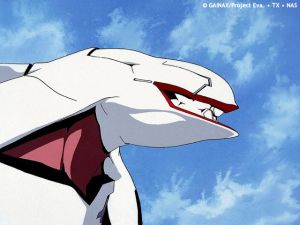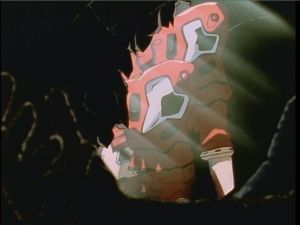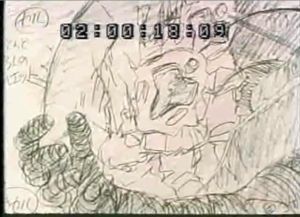The Geektionary H-M
Note: You will notice that The Geektionary occasionally uses first person references in violation of this site's standards and practices. This is the exception that tests the rule. Don't anyone else do this.
More Pages:
H-I
Harpy

One of the Mass Production Model Evangelions. A harpy, in case you weren't aware, is a creature from Greek mythology — part woman, part predatory bird, and generally unpleasant. (Well, that definition of “harpy” might be a perversion of the original intent, but … whatever.) The name is delightfully appropriate for NGE's “Eva Series”, and so it has stuck. Interestingly, the idea to call the MP Evas “harpies” appears to have emerged multiple times independently, as many great ideas do.
Herr Lorenz
Everyone in the show refers to Keel Lorenz by his first name — but wouldn't it be more proper to call him this? (“Herr” is German for “Mr.”, BTW.)
HIP
Human Instrumentality Project. The actual Japanese term is Jinrui Hokan Keikaku, which means something like “Human Complementation Project”. However, Anno decided to confuse everybody and use this opportunity to sneak in another gratuitous sci-fi reference [will elaborate more later], so the official English rendition of J.H.K. is “Human Instrumentality Project”, even though “complementation” and “instrumentality” mean completely different things. Oh, well.
Iron Maiden
See GoS.
K-L
KFR


Kentucky Fried Rei. The corpse of Rei 2 that was (against all probability and logic) recovered by Ritsuko-tachi after Tokyo-3 was vaporized. Created on a whim (by Reichu — who else? @_@) for entirely silly purposes, in vague reference to Shin-seiki's assertion, “I think the gruesome truth is [Rei 2] was roasted alive in the plug.”
Kyoko-sama
In the same vein as Yui-sama — a more “PC” way of referring to EVA-02 (by the name of her soul, rather than by a number), while acknowledging (in typical Reichu fashion…) that becoming an Evangelion has made her great and worthy of the -sama suffix. Extremely silly, but eventually, like “Yui-sama”, other people started using it without any prompting from me…
LCL
Who the hell knows? The EoE Theatrical Program actually bothered to tell us that it isn't “Link Connect(ed/ion) Liquid”. Strangely, it doesn't say what it actually DOES stand for. Bastards. Shin-seiki has suggested that it stands for “Lilith's Creation Liquid”, which is a distinct possibility. Given its source, an alternative expansion for the “C” has also been proposed by AchtungAffen…
LAEM
Live Action Evangelion Movie. This is a project that ADV started around 2003, to the horror, anxiety, or, perhaps less frequently, anticipation of NGE fan-geeks everywhere. With nothing but a script and a handful of concept art by WETA's artists, they promoted the project shamelessly, even including featurettes on their "Directors' Cut" DVDs. Many futile threads emerged debating over whether or not the movie would suck, although things settled down somewhat when, two years later, absolutely no news had emerged. This most impeccable acronym began when Dr. Nick mused, “Hmm, LAEM… I like that acronym. It resembles the word LAME delightfully well.” No more needs to be said, really. Live Action Sequence Remember that weird EoE trailer at the very start of the movie, with all the live action shots that were, well, nowhere in the actual program? Aren't you just dying with curiosity? Go here, NOW. ^_^
Live Action Sequence
Remember that weird EoE trailer at the very start of the movie, with all the live action shots that were, well, nowhere in the actual program? Aren't you just dying with curiosity? Go here, NOW. ^_^
LnY
Longinus no yari (= Spear of Longinus). A proposed replacement for LoL, but nobody really seems to use it.
LoL
Lance of Longinus. This term* was used without a second thought until we learned that “Spear of Longinus” is the official English rendition of Longinus no yari (as proven by a computer screen in #25′) . That “spear” is used is not terribly surprising, considering the very weapon for which the Red Pitchfork of Doom was named is commonly referred to as the “Spear of Destiny”; and, for my part, I've never heard of Jahshua Ha Mashiyach (or Jesus Christ, if you've never heard of the other guy) being poked with a “lance”. Debates have ensued about exactly which type of weapon (spear or lance) the thing in NGE really is, with conclusions being reached on both ends. But, let's face it… In Japanese, “spear” and “lance” are the same word (yari). In Latin — Longinus was a Roman soldier, after all — lancea can mean both “spear” and “lance”. Heck, the Greek word (logche) that references the thing in John 19:34 can apparently mean both. EoE says it's a “spear”. So call it a goddamn spear! Or, alternatively, we could make everyone happy and call it the "Bident of Longinus".
Since the acronym SoL was already used, LnY was proposed as a replacement. This doesn't seem to have quite caught on, though, since, even knowing that calling it a “Lance” is incorrect, a lot of people just can't seem to stop doing it, presumably because (A) “Lance of Longinus” rolls off the tongue, and (B) the acronym is funny. (lol!!!11)
I suspect this silly argument will find its way into an appendix eventually. Better than hogging space here.
- Mr. Tines notes, “‘Lance’ was drawn from Arthurian usage, if nothing else. The usual place (outside NGE) to find mentions of the weapon is in the context of the Dolorous Stroke inflicted on King Pellam by Sir Balin; and even though Malory describes the weapon as ‘that was the same spear that Longius [sic] smote our Lord to the heart’, the weapon is more often referred to as a Lance (given the association with knights in armour).”
Love Eva
A nickname for the “Girlfriend of Steel 2” manga, in homage to Ken Akamatsu's Love Hina. For the English adaptation published in ADV's Newtype US, it was retitled Angelic Days.
LTP
Literal Translation Project. Its members produced a series of original dialogue translations for the TV series -- apparently, not long after the show's debut in Japan -- which were made freely available on their web site, currently located here. Due to their easy obtainability, and possible advantages over the subtitles that ADV's Kuni Kimura produced afterwards, they have been the standard for citation in Internet discussion. However, the advent of Platinum has rendered the LTP scripts largely obsolete and are -- some quibbling aside -- considerably more accurate.
M
Mandorla
The "chrysalis" or "egg case" of an Angel, with which the audience is acquainted in episode #10. This ovular object does not seem to have an official name, as the script refers to it only as "shadow" (kage) and "silhouette". Ritsuko does comment, "It's something like a chrysalis prior to reaching the adult stage" ("Mada kanseitai ni natte inai sanagi no joutai mitai na mono ne"), but the comparison seems somewhat loose. A chrysalis, or pupa, is a stage in the developmental cycle of some insects, where it fits in like so: (1) ova/egg, (2) larva/worm, (3) pupa/chrysalis, (4) imago/adult. (The developers of the Sega Saturn game Second Impression actually took this insect correlation to heart and created a triphasic Angel.) However, other evidence in the show lends some credence to the notion that this structure is, in essence, an egg, and one that Sandalphon (et al.) has been within even when he was inside his mother, Adam.
"Mandorla" was hence proposed as a general-purpose term for the "Angel eggs". Appropriately enough, it is an actual spiritual symbol and, thus, fits into the "esoteric name-borrowing" scheme. The real-life mandorla (Italian for "almond") is a spiritual symbol whose fundamental purpose doesn't matter here. However, in a medieval Christian artistic convention that lasted until the Renaissance, it was depicted as an almond- or oval-shaped nimbus or egg surrounding the figure of a holy figure (Jesus, Mary, the Evangelists, angels, etc.), especially in certain contexts. That was the initial catch for me, although I later stumbled across this: "Mandorla is the Italian word for almond. According to Biedermann (1994), the almond is an ancient symbol for the closing up of valuable contents in a hard, almost impenetrable shell. During the medieval times, the almond was interpreted as a symbol of the embryo enclosed in the uterus. The form of the almond which suggests a stylized vulva may have contributed to such an interpretation (Biederman, 1994).
...which only made the term more appropro, IMO. The two mandorlas that we see in the show aren't quite almond-shaped -- but, then, the ones in religious and spiritual art exhibit a heavy degree of variation themselves.
Mangle Entertainment
Used in reference to Manga Entertainment, which is somewhat notorious for botching its anime releases — not to mention sitting on major licenses for years. :cough:Gunbuster:cough:
McCoy, Sean
“If Matt Greenfield is Batman, Sean McCoy is the Boy Wonder.” —Dr Nick. For actual information, see Platinum Special Features.
Metaphysical Biology (MPB)
Fuyutsuki taught this at Kyoto University before Second Impact -- but what the hell is it? Although the term represents, AFAIK, nothing more than a pseudoscience in the real world, it seems to describe an actual scientific discipline that has developed in the NGE universe: The biology of what is beyond the physical, or, one could say, the biology of souls. The show treats souls as a form of life, and there is a lot of technobabble associated with their workings, so that "metaphysical biology" would be thrown out at us to encompass this weirdness doesn't seem very strange at all. Props to Carl Horn (in a discussion at EMF) for the original idea.
MGNR
Mini Giant Naked Rei. Another absurdity, this one developed because the giant naked Rei-tachi that appear in episode #23 (courtesy of Armisael and EVA-00) could not be called Giant Naked Rei, because there is only one Giant Naked Rei. Ergo, each must be called a Mini Giant Naked Rei.
Mogitai
模擬体: Japanese for “Simulation Body” — you know, those creepy Eva-things from episode #13 that are missing a head and three limbs. Used mostly because “Simulation Body” is annoying to write.
MP
Mass Production (Model Evangelion) = Eva Series (or harpy).
Mythology of Evangelion
See Platinum Special Features.
